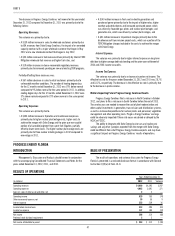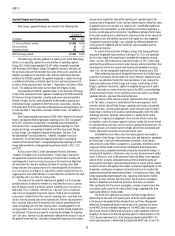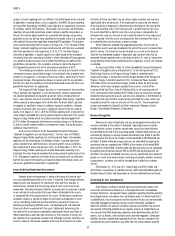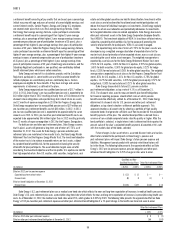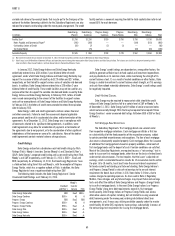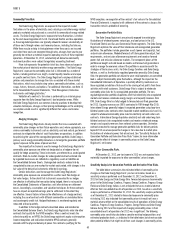Duke Energy 2012 Annual Report Download - page 74
Download and view the complete annual report
Please find page 74 of the 2012 Duke Energy annual report below. You can navigate through the pages in the report by either clicking on the pages listed below, or by using the keyword search tool below to find specific information within the annual report.
54
PART II
contingency is resolved, which could have a material impact on future results of
operations, fi nancial position and cash fl ows of Duke Energy.
Duke Energy Carolinas has experienced numerous claims for
indemnifi cation and medical cost reimbursement relating to damages for
bodily injuries alleged to have arisen from the exposure to or use of asbestos
in connection with construction and maintenance activities conducted by
Duke Energy Carolinas on its electric generation plants prior to 1985. Amounts
recognized as asbestos-related reserves in the respective Consolidated Balance
Sheets totaled $751 million and $801 million as of December 31, 2012 and
2011, respectively, and are classifi ed in Other within Deferred Credits and Other
Liabilities and Other within Current Liabilities. These reserves are based upon
the minimum amount in Duke Energy’s best estimate of the range of loss for
current and future asbestos claims through 2030. Management believes that it is
possible there will be additional claims fi led against Duke Energy after 2030. In
light of the uncertainties inherent in a longer-term forecast, management does not
believe that they can reasonably estimate the indemnity and medical costs that
might be incurred after 2030 related to such potential claims. Asbestos-related
loss estimates incorporate anticipated infl ation, if applicable, and are recorded
on an undiscounted basis. These reserves are based upon current estimates and
are subject to greater uncertainty as the projection period lengthens. A signifi cant
upward or downward trend in the number of claims fi led, the nature of the alleged
injury, and the average cost of resolving each such claim could change our
estimated liability, as could any substantial adverse or favorable verdict at trial.
A federal legislative solution, further state tort reform or structured settlement
transactions could also change the estimated liability. Given the uncertainties
associated with projecting matters into the future and numerous other factors
outside our control, management believes that it is possible Duke Energy may
incur asbestos liabilities in excess of the recorded reserves.
Duke Energy Carolinas has a third-party insurance policy to cover certain
losses related to asbestos-related injuries and damages above an aggregate self
insured retention of $476 million. Duke Energy’s cumulative payments began
to exceed the self insurance retention on its insurance policy in 2008. Future
payments up to the policy limit will be reimbursed by Duke Energy’s third-party
insurance carrier. The insurance policy limit for potential future insurance
recoveries for indemnifi cation and medical cost claim payments is $935 million
in excess of the self insured retention. Insurance recoveries of $781 million and
$813 million related to this policy are classifi ed in the Consolidated Balance
Sheets in Other within Investments and Other Assets and Receivables as of
December 31, 2012 and 2011, respectively. Duke Energy is not aware of any
uncertainties regarding the legal suffi ciency of insurance claims. Management
believes the insurance recovery asset is probable of recovery as the insurance
carrier continues to have a strong fi nancial strength rating.
For further information, see Note 5 to the Consolidated Financial
Statements, “Commitments and Contingencies.”
Accounting for Income Taxes
Signifi cant management judgment is required in determining Duke Energy’s
provision for income taxes, deferred tax assets and liabilities and the valuation
allowance recorded against Duke Energy’s net deferred tax assets, if any.
Deferred tax assets and liabilities are recognized for the future tax
consequences attributable to differences between the book basis and tax basis
of assets and liabilities. Deferred tax assets and liabilities are measured using
enacted tax rates expected to apply to taxable income in the years in which those
temporary differences are expected to be recovered or settled. The probability
of realizing deferred tax assets is based on forecasts of future taxable income
and the use of tax planning that could impact the ability to realize deferred
tax assets. If future utilization of deferred tax assets is uncertain, a valuation
allowance may be recorded against certain deferred tax assets.
In assessing the likelihood of realization of deferred tax assets,
management considers estimates of the amount and character of future taxable
income. Actual income taxes could vary from estimated amounts due to the
impacts of various items, including changes to income tax laws, Duke Energy’s
forecasted fi nancial condition and results of operations in future periods, as well
as results of audits and examinations of fi led tax returns by taxing authorities.
Although management believes current estimates are reasonable, actual results
could differ from these estimates.
Signifi cant judgment is also required in computing Duke Energy’s
quarterly effective tax rate (ETR). The ETR calculations are revised each quarter
based on the best annual tax assumptions available at that time, including, but
not limited to, income levels, deductions and credits. In accordance with interim
tax reporting rules, a tax expense or benefi t is recorded every quarter to adjust
for the difference in tax expense computed based on the actual year-to-date ETR
versus the forecasted annual ETR, excluding discrete items impacting income
tax expense that have occurred year-to-date.
Duke Energy recognizes tax benefi ts for positions taken or expected to
be taken on tax returns, including the decision to exclude certain income or
transactions from a return, when a more-likely-than-not threshold is met for
a tax position and management believes that the position will be sustained
upon examination by the taxing authorities. Duke Energy records the largest
amount of the tax benefi t that is greater than 50% likely of being realized
upon settlement. Management evaluates each position based solely on the
technical merits and facts and circumstances of the position, assuming the
position will be examined by a taxing authority having full knowledge of all
relevant information. Signifi cant management judgment is required to determine
recognition thresholds and the related amount of tax benefi ts to be recognized in
the Consolidated Financial Statements. Management reevaluates tax positions
when new information about recognition or measurement becomes available.
The portion of the tax benefi t which is uncertain is disclosed in the notes to the
Consolidated Financial Statements.
Undistributed foreign earnings associated with International Energy’s
operations are considered indefi nitely reinvested. As a result, no U.S. tax
is recorded on such earnings. This assertion is based on management’s
determination that the cash held in International Energy’s foreign jurisdictions
is not needed to fund the operations of its U.S. operations and that International
Energy either has invested or has intentions to reinvest such earnings. While
management currently intends to indefi nitely reinvest all of International
Energy’s unremitted earnings, should circumstances change, Duke Energy
may need to record additional income tax expense in the period in which
such determination changes. The cumulative undistributed earnings as of
December 31, 2012, on which Duke Energy has not provided deferred U.S.
income taxes and foreign withholding taxes is approximately $2.0 billion. The
amount of unrecognized deferred tax liability related to these undistributed
earnings is estimated at between $275 million and $350 million.
For further information, see Note 24 to the Consolidated Financial
Statements, “Income Taxes.”
Pension and Other Post-Retirement Benefi ts
The calculation of pension expense, other post-retirement benefi t expense
and pension and other post-retirement liabilities require the use of assumptions.
Changes in these assumptions can result in different expense and reported
liability amounts, and future actual experience can differ from the assumptions.
Duke Energy believes that the most critical assumptions for pension and other
post-retirement benefi ts are the expected long-term rate of return on plan
assets and the assumed discount rate. Additionally, medical and prescription
drug cost trend rate assumptions are critical to Duke Energy’s estimates of
other post-retirement benefi ts.
Funding requirements for defi ned benefi t plans are determined by
government regulations. Duke Energy made voluntary contributions to its defi ned
benefi t retirement plans of $200 million in 2012, $200 million in 2011, and
$400 million in 2010 and mandatory contributions of $104 million in 2012.
In 2013, Duke Energy anticipates making $350 million of contributions to its
defi ned benefi t plans.
Duke Energy and its subsidiaries, including Progress Energy and Cinergy,
maintain, and the Subsidiary Registrants participate in, non-contributory defi ned
benefi t retirement plans. The plans cover most U.S. employees using a cash
balance formula. Under a cash balance formula, a plan participant accumulates





